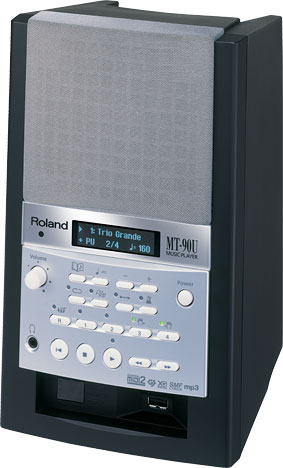Creative Solutions For Inspired Learning
Menu
Creative Solutions For Inspired Learning
MenuBy Martha Baker-Jordan

Roland MT-90U: Music Player
For years, whenever a technical situation has arisen for which I’ve needed professional help accompanied by large doses of empathy, I quote something I heard Amanda Vick Lethco say in a workshop. She was making some observations about the then-embryonic state of technology and, in her wonderful, humorous way, announced that not only was she “Ms. Low-Tech,” but she was “Ms. No-Tech!”
Many piano teachers may not publicly utter this self-deprecating statement, but it must surely be felt. The rapid rise of technology can sometimes be overwhelming, even to fairly knowledgeable “techno-literates.” But technology is here to stay, and although not all piano teachers will be willing or able to use what’s available, it is a fact that all teaching can be enhanced with its addition, ranging from a basic computer to the most sophisticated notation program. Here are some suggestions:
I have used a Roland digital sequencer and sound module in my university Music-major piano classes at California State University, Fullerton, and in my home studio for several years. In the university classes, it is used with Alfred’s Group Piano for Adults I and II by Lancaster and Renfrow, along with additional ensemble repertoire and my own creations. In my home studio, where I teach students from ages seven through high school, the sequencer and sound module serve the same purposes as in the university piano classes, except my private students compose original compositions and use them for orchestrating them. The pedagogical advantages of this technology are invaluable in my university curriculum, which teaches the skills that are essential for all musicians, as well as being mandated for accreditation by the National Association of Schools of Music.
For most class activities, the sounds are heard in each student’s headset. In the lab configuration, students hear only their keyboard and the instructor’s keyboard and voice. For ensemble and repertoire, all pianos are heard simultaneously. Some of the important skills taught with the sequencer and sound module are:
The range of rhythmic abilities in university piano classes can be astounding and frightening! In a 20-unit lab, there can be 20 different levels of rhythmic abilities. All must achieve rhythmic competence at the proficiency levels set in my curriculum. In addition to my own drills, the Lancaster/Renfrow text provides numerous excellent rhythm drills with an accompaniment and/or rhythm background played through the sequencer and sound module. Access to a large variety of tempi while performing increasingly difficult rhythmic drills is, to me, the most valuable feature; the instructor can change tempi quickly and easily. The sequencer has definitely improved my students’ rhythmic abilities.
Purists might say that after a first run-through, the second playing is no longer sight playing. But at the elementary levels, I do not agree. Sight playing at the early stages of learning to read music is difficult, and two or three more attempts brings increased accuracy and confidence. When my classes sight play, I begin with a slow tempo and increase it with each repetition. The main pedagogical advantage is that the sequencer requires the student to keep going without stopping and going back to fix things, which is the first and foremost requirement for improving sight playing.
Our three required semesters of class piano (meeting three times a week) follow the pedagogically proven mode of sequential teaching and learning. As everything builds on the previous elements taught, nothing is taught in isolation and then forgotten and never used again. In harmonization and transposition, the primary chords are taught first, and students work with these chords until they can harmonize and transpose at sight before going on to secondary chords. The most common materials used to teach music majors how to harmonize and transpose are folk songs. Sadly, many students now entering music schools have had very little exposure to the rich literature of folk songs in their public schools, and many do not have the basic I-IV-V sounds in their ears. To teach them to harmonize, we dissect the melodies so that they learn to recognize tonic-triad tones and non-tonic triad tones in the melody. Then they learn that the tonic (I) chord goes with tonic-triad tones of the melody and the dominant (V) chord harmonizes the non-tonic triad tones.
At the conclusion of three semesters, all students must be able to harmonize and transpose melodies at sight using primary, secondary, and secondary dominant chords with a varied left-hand accompaniment. The sequencer assists in many ways when I:
Many teachers never teach improvisation because they do not know how to improvise. With the sequencer, one does not have to know how to improvise in order to teach it. Some of the strongest pedagogical reasons for teaching it are:
When improvising, nothing you do is wrong! And while there are many ways in which the sequencer and sound module assist in improvisation, the primary feature is providing appropriate, interesting accompaniments while students improvise. They feel like they are doing much more than they actually are thanks to the instant accompaniment. I often use it acoustically with the automatic repeat button on while each student plays his or her improvisation for the rest of the class. There are some disasters along the way, but just as often, we have a positive performance experience.
Some suggest that using technology with ensemble and solo repertoire is the best and easiest place to begin. But whatever you decide, start using some kind of technology in your teaching. The pedagogical benefits far outweigh the time and energy you’ll spend learning how to use a sequencer, sound module, or other technology of your choice.